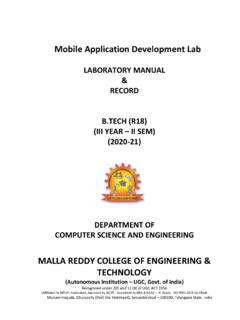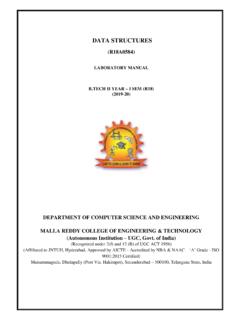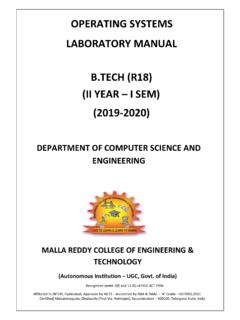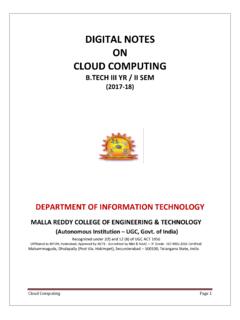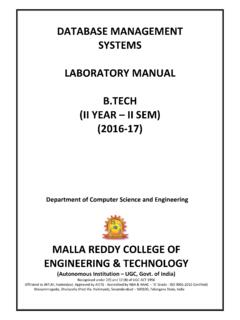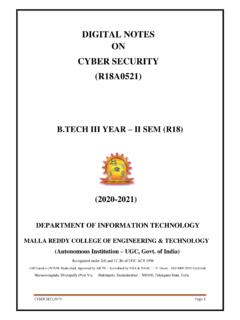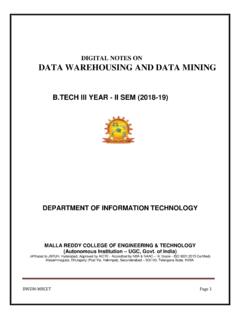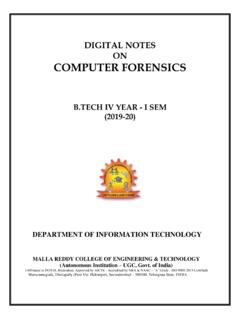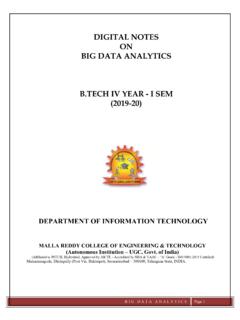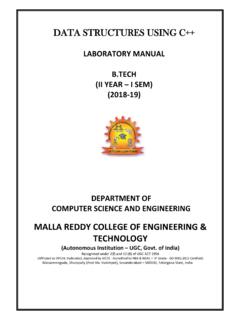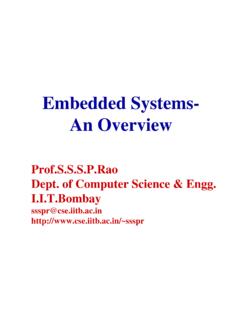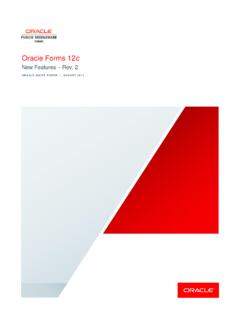Transcription of DIGITAL NOTES ON Mobile Application Development B.TECH …
1 Mobile Application Development DIGITAL NOTES ON Mobile Application Development IV YEAR - I SEM (2019-20) DEPARTMENT OF INFORMATION TECHNOLOGY MALLA REDDY COLLEGE OF ENGINEERING & TECHNOLOGY (Autonomous Institution UGC, Govt. of India) (Affiliated to JNTUH, Hyderabad, Approved by AICTE - Accredited by NBA & NAAC A Grade - ISO 9001:2015 Certified) Maisammaguda, Dhulapally (Post Via. Hakimpet), Secunderabad 500100, Telangana State, INDIA. Mobile Application Development MALLA REDDY COLLEGE OF ENGINEERING & TECHNOLOGY DEPARTMENT OF INFORMATION TECHNOLOGY IV Year IT I Sem L T /P/D C 5 1/-/- 4 (R15A0563) Mobile Application Development UNIT I Introduction to Mobile A brief history of Mobile , The Mobile Ecosystem, Why Mobile ?
2 , Types of Mobile Applications, Mobile Information Architecture, Mobile Design, Mobile , Mobile Web Development , Small Computing Device Requirements. J2ME: Overview The World of java , Inside J2ME, J2ME Architecture, MIDlet Programming, J2ME Wireless Toolkit, Hello World J2ME Style, Multiple MIDlets in a MIDlet Suite UNIT II Introduction to Android: History of Android, Introduction to Android, Operating Systems, Android Development Tools, Android Architecture. UNIT III Development Tools: Installing and using Eclipse with ADT plug-in, Installing Virtual machine for Android sandwich/Jelly bean (Emulator), configuring the installed tools, creating a android project Hello Word, run on emulator, Deploy it on USB-connected Android device UNIT IV User Interface Architecture: Application context, intents, Activity life cycle, multiple screen sizes User Interface Design: Form widgets, Text Fields, Layouts, Button control, toggle buttons, Spinners(Combo boxes),Images, Menu, Dialog.
3 UNIT V Database: Understanding of SQLite database, connecting with the database TEXTBOOKS: 1. J2ME: The Complete Reference, James Keogh, Tata McGrawHill 2. Android Application Development for java programmers. By James C. Sheusi. Publisher: Cengage Learning, 2013. 3. Lauren Darcey and Shane Conder, Android Wireless Application Development , Pearson Education, 2nd ed. (2011) Mobile Application Development MALLA REDDY COLLEGE OF ENGINEERING & TECHNOLOGY DEPARTMENT OF INFORMATION TECHNOLOGY INDEX S. No Unit Topic Page no 1 I Introduction to Mobile 1 2 I Mobile Information Architecture 2 3 I J2ME 4 4 II Introduction to Android 10 5 II Android Development Tools 11 6 III Installing & Using Eclipse with ADT Plug-in 14 7 III Installing Virtual Machine for Android Jelly bean (Emulator)
4 15 8 III Configuring the installed tools 17 9 III Creating an Android Project 19 10 III Deploy it on USB-connected Android Device 21 11 IV User Interface Architecture 23 12 IV Activity Life Cycle 23 13 IV User Interface Design 24 14 V Understanding of SQLite database 26 15 V Connecting with the database 49 Mobile Application Development Page | 1 MALLA REDDY COLLEGE OF ENGINEERING & TECHNOLOGY DEPARTMENT OF INFORMATION TECHNOLOGY UNIT -I A BRIEF HISTORY OF Mobile Mobile phones have changed the way we live our lives providing voice calling, text messaging and Mobile Internet access. The very first Mobile phones were two-way radios that allowed taxi drivers and the emergency services to communicate. Motorola, on 3 April 1973 was first company to mass produce the first handheld Mobile phone.
5 PRE-STANDARDISATION OR 0 G AT&T was one of the first to commercialize Mobile telecommunication in 1947. The service known simply as Mobile Telephone Service (MTS) spread to more than a hundred towns and highway paths by the end of the year. The service relied on an operator to connect both incoming and outgoing calls. The first generation of cellular networks paved the way to the networks. Use of multiple cell tower sites, each connected through a network, allowed users to travel and even switch cell towers during a call. It was a revolution built on existing, analog technology with the first being built in Chicago in 1977. Known as the Analog Mobile Phone System (AMPS), it was built by AT&T and it took FCC 11 years to approve AT&T s initial proposal in 1971.
6 Advancement by 2G was the introduction of SMS messaging, with the first computer generated SMS sent in 1992 in the UK. The very first download services were also introduced using 2G technology and enabled users to download ringtones. Mobile phones also saw use as another method of payment for services like car parking in Finland and vending machines. 3G transformed the Mobile phone industry and enabled widespread Mobile Internet and the transmission services like TV and Radio for the very first time. Handset manufacturers jumped on the bandwagon and smartphone use took off. IP networks, bringing Mobile Internet more in-line with wired home Internet is of course the big advantage.
7 The fourth generation of Mobile communication is still evolving, and we re bound to see new standards, speed increases and coverage benefits in the next few years. THE Mobile ECO-SYSTEM Mobile Ecosystem is a collection of multiple devices ( Mobile phones, Tablet, Phablet etc), software (operating system, Development tools, testing tools etc), companies(device manufacturers, carrier, apps stores, Development /testing companies) and the process by which data (sms, bank-transactions etc.) is transferred/ shared by a user from one device to another device or by the device itself based on some programs(Birthday, Wedding Messages, Calendar). Data (Text, Multi-media, and VOICE) sharing can be done between devices of the same operating system or different operating systems.
8 Examples Iphone (IOS) to Windows Phone, Iphone IOS to Nexus(Android), Motorola(Android) to Nexus(Android). Data can also be shared between multiple devices with the same operating system of the same manufacturer. Why Mobile ? Mobile phones are used widely in our day-to-day lives giving us the freedom to communicate anywhere and at anytime. The latest Mobile phones are incorporated with features like MP3 players, high resolution camera, high sound quality, 3G technology and the list goes on. Mobile Application Development Page | 2 The Mobile phone allows us to connect to other compatible devices, surf the internet, listen to music, play games and capture our precious moments. These latest Mobile phones are stylish in looks and excellent in terms of usability and functions.
9 The 3G phones allow doing video calling and video conferencing. These phones allow fast data exchange and information apart from faster data downloads via internet. MMS, SMS, Email client and instant messaging as well as multimedia capabilities, gaming etc; are added features of latest Mobile phones. Types of Mobile Applications Native apps are built for a specific operating system. A native app developed for iOS operating system won t work on Android devices and vice-versa. If an app is developed for iOS, it will remain exclusive to that operating system. Softwares' used to develop native apps generally would be Objective-C or Swift for iOS, java and ADT for Android operating system and .NET(C#) for Windows operating system.
10 Mobile web apps are the web applications to render/deliver pages on web browsers running in Mobile devices. Since these apps target browsers, they work on different Mobile operating systems. You can view a Mobile web app on Android, iOS or Windows tablets and phone devices. They also work on PC web browsers. Softwares' used to develop these applications are generally HTML, CSS, JavaScript, JQuery. Hybrid apps are a mixture of both native and Mobile web apps. This type of Application has cross-platform compatibility but can still access phone s hardware. Softwares used to develop these apps are generally HTML, CSS, Javascript, JQuery, Mobile Javascript frameworks, Cordova/PhoneGap etc. Mobile Information Architecture While designing a Mobile , the following steps need to be followed.
